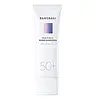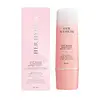What's inside
What's inside
 Key Ingredients
Key Ingredients

 Benefits
Benefits

 Concerns
Concerns

 Ingredients Side-by-side
Ingredients Side-by-side

Arctium Lappa Root Extract
Skin ConditioningWater
Skin ConditioningDicaprylyl Carbonate
EmollientGlycerin
HumectantDibutyl Adipate
EmollientDiethylamino Hydroxybenzoyl Hexyl Benzoate
UV FilterHydrogenated Polyisobutene
EmollientDipropylene Glycol
Humectant1,2-Hexanediol
Skin ConditioningNiacinamide
SmoothingEthylhexyl Triazone
UV AbsorberSilybum Marianum Seed Extract
Skin ConditioningSalvia Officinalis Leaf Extract
CleansingHouttuynia Cordata Extract
Skin ConditioningLeontopodium Alpinum Extract
Skin ConditioningJasminum Officinale Extract
MaskingLilium Tigrinum Extract
Skin ConditioningEthylhexyl Olivate
Skin ConditioningCetearyl Olivate
Sodium Acrylates Copolymer
Butylene Glycol
HumectantSorbitan Olivate
EmulsifyingPolyglyceryl-4 Oleate
EmulsifyingAdenosine
Skin ConditioningEthylhexylglycerin
Skin ConditioningTocopherol
AntioxidantDisodium EDTA
Arctium Lappa Root Extract, Water, Dicaprylyl Carbonate, Glycerin, Dibutyl Adipate, Diethylamino Hydroxybenzoyl Hexyl Benzoate, Hydrogenated Polyisobutene, Dipropylene Glycol, 1,2-Hexanediol, Niacinamide, Ethylhexyl Triazone, Silybum Marianum Seed Extract, Salvia Officinalis Leaf Extract, Houttuynia Cordata Extract, Leontopodium Alpinum Extract, Jasminum Officinale Extract, Lilium Tigrinum Extract, Ethylhexyl Olivate, Cetearyl Olivate, Sodium Acrylates Copolymer, Butylene Glycol, Sorbitan Olivate, Polyglyceryl-4 Oleate, Adenosine, Ethylhexylglycerin, Tocopherol, Disodium EDTA
Water
Skin ConditioningButyl Methoxydibenzoylmethane
UV AbsorberOctocrylene
UV AbsorberTitanium Dioxide
Cosmetic ColorantEthylhexyl Salicylate
UV AbsorberZinc Oxide
Cosmetic ColorantGlycine Soja Phytoplacenta Extract
Skin ConditioningGlycerin
HumectantPhospholipids
Skin ConditioningGlycereth-26
HumectantAluminum Hydroxide
EmollientHydroxyethyl Urea
HumectantNiacinamide
SmoothingRoyal Jelly
Butylene Glycol
Humectant1,2-Hexanediol
Skin ConditioningLecithin
EmollientHydrogenated Lecithin
EmulsifyingDipotassium Glycyrrhizate
HumectantChamaecyparis Obtusa Leaf Extract
Skin ConditioningPotassium Olivoyl PCA
CleansingCeramide NP
Skin ConditioningTromethamine
BufferingGalactoarabinan
Caprylyl Glycol
EmollientHydroxypropyl Cyclodextrin
MaskingMelatonin
AntioxidantAdenosine
Skin ConditioningSodium Hyaluronate
HumectantPhenoxyethanol
PreservativeEthylhexylglycerin
Skin ConditioningWater, Butyl Methoxydibenzoylmethane, Octocrylene, Titanium Dioxide, Ethylhexyl Salicylate, Zinc Oxide, Glycine Soja Phytoplacenta Extract, Glycerin, Phospholipids, Glycereth-26, Aluminum Hydroxide, Hydroxyethyl Urea, Niacinamide, Royal Jelly, Butylene Glycol, 1,2-Hexanediol, Lecithin, Hydrogenated Lecithin, Dipotassium Glycyrrhizate, Chamaecyparis Obtusa Leaf Extract, Potassium Olivoyl PCA, Ceramide NP, Tromethamine, Galactoarabinan, Caprylyl Glycol, Hydroxypropyl Cyclodextrin, Melatonin, Adenosine, Sodium Hyaluronate, Phenoxyethanol, Ethylhexylglycerin
Ingredients Explained
These ingredients are found in both products.
Ingredients higher up in an ingredient list are typically present in a larger amount.
1,2-Hexanediol is a synthetic liquid and another multi-functional powerhouse.
It is a:
- Humectant, drawing moisture into the skin
- Emollient, helping to soften skin
- Solvent, dispersing and stabilizing formulas
- Preservative booster, enhancing the antimicrobial activity of other preservatives
Adenosine is in every living organism. It is one of four components in nucleic acids that helps store our DNA.
Adenosine has many benefits when used. These benefits include hydrating the skin, smoothing skin, and reducing wrinkles. Once applied, adenosine increases collagen production. It also helps with improving firmness and tissue repair.
Studies have found adenosine may also help with wound healing.
In skincare products, Adenosine is usually derived from yeast.
Learn more about AdenosineButylene Glycol (or BG) is used within cosmetic products for a few different reasons:
Overall, Butylene Glycol is a safe and well-rounded ingredient that works well with other ingredients.
Though this ingredient works well with most skin types, some people with sensitive skin may experience a reaction such as allergic rashes, closed comedones, or itchiness.
Learn more about Butylene GlycolEthylhexylglycerin (we can't pronounce this either) is commonly used as a preservative and skin softener. It is derived from glyceryl.
You might see Ethylhexylglycerin often paired with other preservatives such as phenoxyethanol. Ethylhexylglycerin has been found to increase the effectiveness of these other preservatives.
Glycerin is already naturally found in your skin. It helps moisturize and protect your skin.
A study from 2016 found glycerin to be more effective as a humectant than AHAs and hyaluronic acid.
As a humectant, it helps the skin stay hydrated by pulling moisture to your skin. The low molecular weight of glycerin allows it to pull moisture into the deeper layers of your skin.
Hydrated skin improves your skin barrier; Your skin barrier helps protect against irritants and bacteria.
Glycerin has also been found to have antimicrobial and antiviral properties. Due to these properties, glycerin is often used in wound and burn treatments.
In cosmetics, glycerin is usually derived from plants such as soybean or palm. However, it can also be sourced from animals, such as tallow or animal fat.
This ingredient is organic, colorless, odorless, and non-toxic.
Glycerin is the name for this ingredient in American English. British English uses Glycerol/Glycerine.
Learn more about GlycerinNiacinamide is a multitasking form of vitamin B3 that strengthens the skin barrier, reduces pores and dark spots, regulates oil, and improves signs of aging.
And the best part? It's gentle and well-tolerated by most skin types, including sensitive and reactive skin.
You might have heard of "niacin flush", or the reddening of skin that causes itchiness. Niacinamide has not been found to cause this.
In very rare cases, some individuals may not be able to tolerate niacinamide at all or experience an allergic reaction to it.
If you are experiencing flaking, irritation, and dryness with this ingredient, be sure to double check all your products as this ingredient can be found in all categories of skincare.
When incorporating niacinamide into your routine, look out for concentration amounts. Typically, 5% niacinamide provides benefits such as fading dark spots. However, if you have sensitive skin, it is better to begin with a smaller concentration.
When you apply niacinamide to your skin, your body converts it into nicotinamide adenine dinucleotide (NAD). NAD is an essential coenzyme that is already found in your cells as "fuel" and powers countless biological processes.
In your skin, NAD helps repair cell damage, produce new healthy cells, support collagen production, strengthen the skin barrier, and fight environmental stressors (like UV and pollution).
Our natural NAD levels start to decline with age, leading to slower skin repair, visible aging, and a weaker skin barrier. By providing your skin niacinamide, you're recharging your skin's NAD levels. This leads to stronger, healthier, and younger looking skin.
Another name for vitamin B3 is nicotinamide. This vitamin is water-soluble and our bodies don't store it. We obtain Vitamin B3 from either food or skincare. Meat, fish, wheat, yeast, and leafy greens contain vitamin B3.
The type of niacinamide used in skincare is synthetically created.
Learn more about NiacinamideWater. It's the most common cosmetic ingredient of all. You'll usually see it at the top of ingredient lists, meaning that it makes up the largest part of the product.
So why is it so popular? Water most often acts as a solvent - this means that it helps dissolve other ingredients into the formulation.
You'll also recognize water as that liquid we all need to stay alive. If you see this, drink a glass of water. Stay hydrated!
Learn more about Water